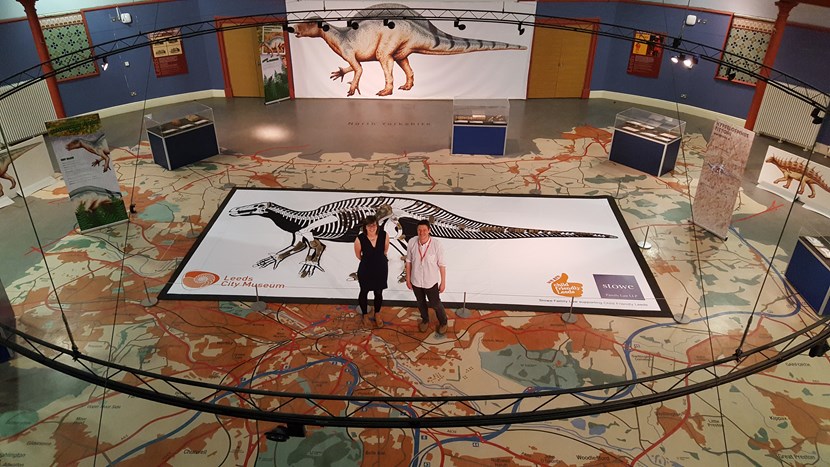
27 May 2016
No bones about it- dinosaurs have arrived at Leeds City Museum
Visitors to Leeds City Museum this May half term can journey back to a time when dinosaurs ruled the earth.
Starting this Saturday, May 28, the museum will be playing host to a brand new Dinosaur Week exhibition, which features an impressive array of prehistoric specimens spanning hundreds of millions of years of natural history.
The highlight of the exhibition will be Leeds Museums and Galleries' partial skeleton of a 25ft long fossilised Hypselospinus, which for the first time ever has been reconstructed and displayed across the floor of the museum’s Brodrick Hall.
A special time lapse video, filmed over the past two weeks, shows curators tackling the painstaking process of assembling more than 100 individual fossils to put the giant plant eater's remains together.
Other dinosaur discoveries on show over the half term week will be the 80 million year-old forelimb of duck-billed herbivore Edmontosaurus, and the egg of long-necked sauropod Hypselosaurus.
Also displayed will be a cast of flying dinosaur Archaeopteryx, an exact replica of the famous original at London’s Natural History Museum.
The exhibition also features a cast of the tooth of iconic carnivore Tyrannosaurus Rex, which had the largest teeth of any meat eating dinosaur.
Neil Owen, Leeds Museums and Galleries' assistant curator for natural sciences and geology, has been putting the display together ahead of Saturday’s opening.
He said: “Assembling Hypselospinus has taken a lot of work, but we’re very excited about welcoming visitors for Dinosaur Week because we know just how fascinated and enthusiastic people of all ages are about these incredible animals.
“Dinosaurs have a uniquely timeless power to enthral and engage, conjuring up images of a very different world filled with giant herbivores and ferocious predators.
“What we hope to do with this collection of fossils is bridge the gap between that world and ours to give visitors over the May half term an insight into how life on earth has changed and evolved over hundreds of millions of years.”
The Hypselospinus skeleton is usually housed at the Leeds Discovery Centre and was originally found near Rye in East Sussex in 1866.
The animal lived in the early Cretaceous period, around 137 million years ago, and its assembled remains include a near complete tail, right hind limb and foot along with incomplete forelimbs, vertebra, ribs, pelvis and an extremely rare skull fragment.
Councillor Brian Selby, Leeds City Council’s lead member for museums and galleries, said:
“This exhibition has already created a real buzz around the museum and the city and we know that visitors can’t wait to see a real dinosaur on display for the first time.
“Dinosaurs fire people’s imaginations like nothing else, encouraging them to look at history, science and the natural world from a completely different perspective.
“I know the museum team has put a tremendous amount of work into ensuring our superb collection of fossils goes on display in a way which taps into the public’s enthusiasm and I’m sure it will be a memorable experience for visitors over the half term.”
During Dinosaur Week, which runs until June 5, visitors will also have the chance to enjoy dino-tours and hands-on activities and those who come in a dinosaur costume could win a spot prize.
The display is sponsored by Leeds based family law solicitors Stowe Family Law, supporting Child Friendly Leeds.
For more information, contact the museum on 0113 224 3732 or email city.museum@leeds.gov.uk
ENDS
Factfile: Dinos on display
- The Hypselospinus on display is an immature juvenile between four and six years old. It would have walked mainly on all fours but could walk on two legs to move faster.
- The Hypselosaurus egg was found in France and dates from the Cretaceous period, around 66-70 million years ago. The dinosaur’s eggs are unusually large, often measuring up to a foot in diameter, and had very thin shells.
- Two 140m year-old coprolites (fossilised dinosaur dung) are also on display. They come from an unknown dinosaur and were found Utah, USA.
- Archaeopteryx was a feathered, flying dinosaur that had teeth and a retractable killing claw on its second toe.
- A Deinonychus claw cast is also on display. Deinonychus, a member of the Dromaeosaurus family, was a highly intelligent predator whose name means “terrible claw”.
- The Tyrannosaurus Rex tooth cast shows how huge and terrifying the iconic meat-eater must have been. Around 4ft of the animal’s 5ft skull was jaw, packed with the largest fossil serrated teeth ever recorded.
For media enquiries contact:
Leeds City Council Communications team
communicationsteam@leeds.gov.uk